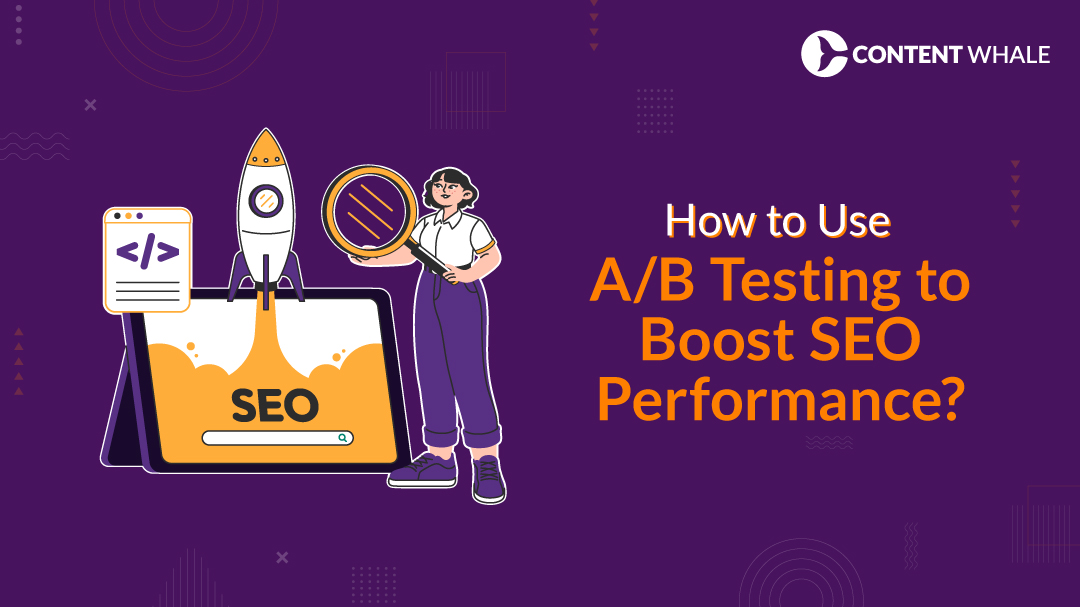Most businesses spend hours perfecting blog content, yet ignore one line that can decide whether a user clicks or scrolls past — The SEO description.
This small snippet doesn’t directly boost rankings, but it plays a key role in improving your SERP click-through rate. Google’s algorithm now uses engagement metrics like dwell time and bounce rate to judge content relevance.
A well-written meta description influences both and at Content-Whale, we help brands write ones that actually convert. This blog shares 50+ actionable tips, real meta description examples, templates, and updated SEO optimization meta description techniques to help you master writing descriptions that 101% of users will click.
What Are SEO Descriptions?
A SEO description is the short summary text that appears below your page title in search results. It’s not a ranking factor, but it directly impacts clicks. Google may rewrite it, but a strong description still guides how your content appears on SERPs.
A) Basic Definition and Purpose
A meta description gives users a snapshot of what your page offers. It sets expectations and encourages action.
B) Where SEO Descriptions Appear in Google
They show up below the title in both desktop and mobile search results, often becoming the deciding factor in clicks.
C) Misconceptions About Meta Tags (and What They Really Do)
Many believe meta tags help with rankings. They don’t. But a compelling description aligned with intent improves SEO optimization meta description performance by influencing CTR.
That’s why writing strong SEO descriptions is less about algorithms and more about influencing real people—let’s see why that still matters in 2025.
50+ Actionable Tips to Write Great SEO Descriptions
Whether you’re writing for blogs, product listings, or landing pages, each SEO description needs to connect with intent, trigger action, and fit within Google’s display limits.
Below are 50+ practical tips, grouped by use case, that reflect the meta description best practices SEO professionals follow in 2025:
Blog Pages – Build Curiosity & Boost Engagement
For blog content, your SEO description should spark interest and match search intent. These tips help improve visibility and boost your SERP click-through rate without overloading on keywords.
Tip 1: Start with a clear question.
Asking a direct question hooks the reader and mirrors common search behavior. It shows your blog answers something specific.
Example: “What’s the healthiest way to lose weight without skipping meals?”
Tip 2: Highlight the takeaway.
Tell users what they’ll learn or solve. Focus on value, not fluff. This builds trust and drives action.
Example: “Master your monthly budget with these simple finance rules.”
Tip 3: Use curiosity-driven phrasing.
Phrases that tease just enough to create interest get more clicks. They tap into the need to “find out.”
Example: “Most remote workers ignore this one productivity trick.”
Tip 4: Add numbers or data.
Numbers give structure and specificity. They help your SEO description stand out in a sea of vague results.
Example: “5 Ayurvedic herbs that actually improve digestion.”
Tip 5: Use the keyword early.
Placing your primary keyword—like SEO descriptions—early increases visibility and aligns better with search intent.
Tip 6: Include a soft CTA.
A subtle prompt like “Discover how” or “Learn the trick” encourages readers to take the next step.
Example: “Discover the top universities in Europe for Indian students.”
Tip 7: Stick to active voice verbs.
Active verbs make descriptions more direct and actionable. They keep your copy lean and persuasive.
Example: “Grow your savings with these smart investing habits.”
Tip 8: Match the tone to your blog.
Your tone sets expectations. If your blog is casual, keep the meta light. If it’s technical, make it direct.
Tip 9: Use urgency when appropriate.
Urgency motivates clicks when time or relevance matters. It’s effective for trends, deadlines, or offers.
Example: “Apply for Canada PR before new rules take effect.”
Tip 10: Focus on the benefit.
Shift from “what’s inside” to “what’s in it for them.” Benefits drive interest better than descriptions.
Example: “Plan a 3-day Bali trip on a ₹25,000 budget.”
Product Pages – Focus on Benefits & Conversions
Product page SEO descriptions should drive conversions, not just visibility. These tips focus on clarity, benefits, and urgency.
Following proven meta description best practices SEO experts use in ecommerce;
Tip 11: Mention the main benefit first.
Lead with the one thing users care about most—what the product does for them.
Example: “Stay hydrated all day with this spill-proof, BPA-free water bottle.”
Tip 12: Combine a power word with the core benefit.
Words like “instant“, “gentle“, or “premium” create emotional pull and help your product stand out.
Example: “Instant hydration for dry skin with our lightweight face mist.”
Tip 13: Include delivery or return info.
If you offer fast shipping, cash on delivery, or easy returns, mention it. It removes hesitation.
Example: “Get it delivered in 2 days. No hassle 7-day returns.”
Tip 14: Use emotional triggers.
Words like “safe,” “clean,” “pure,” or “luxury” tap into subconscious needs.
Example: “Crafted with clean ingredients. No sulfates, no parabens.”
Tip 15: Add a direct CTA.
Unlike blogs, product pages benefit from strong CTAs.
Example: “Order now and get 10% off.”
Tip 16: Mention discounts or limited offers.
Highlight price drops, free gifts, or first-time buyer discounts.
Example: “Flat 25% off this weekend only. Shop the deal now.”
Tip 17: Use sensory words.
Words that describe how something feels, smells, or looks add vividness and make the product more desirable.
Example: “Rich cocoa fragrance with a silky smooth finish.”
Tip 18: Show urgency with availability.
Low stock or limited availability encourages quicker decision-making.
Example: “Only 3 left in stock. Grab yours before it’s gone.”
Tip 19: Include brand + product type if targeting brand-aware users.
Brand-aware shoppers often search by name, so include both for better match.
Example: “Nike Pegasus 41 Running Shoes. Light, Fast, Reliable.”
Tip 20: Keep keywords natural, not forced.
Overstuffing hurts credibility. Use SEO descriptions that read like human-written copy while naturally including key terms.
Service Pages – Show Trust, Value & Action
Service page SEO descriptions must build trust quickly. Focus on outcomes, credibility, and relevance.
These tips use proven SEO optimization meta description techniques to drive more inquiries:
Tip 21: Lead with a value proposition.
Start with the core result your service delivers—not just what it does. This tells users what they’ll gain by choosing you.
Example: “Grow qualified leads with expert B2B content strategy.”
Tip 22: Mention years of experience or trust signals.
Trust is key for service-based businesses. Show scale, experience, or certifications in your SEO description to build credibility.
Example: “10+ years helping 1,200+ brands optimize performance.”
Tip 23: Use action words to drive engagement.
Phrases like “book,” “schedule,” or “get started” make the meta copy active and conversion-focused.
Example: “Schedule a free trial for our employee training platform.”
Tip 24: Include location if targeting local search.
Local SEO descriptions should clearly mention the service area. This helps rank better in geo-based queries.
Example: “Trusted accounting services in Mumbai for small businesses.”
Tip 25: Add the audience or niche.
Specificity matters. Mentioning your ideal client improves relevance and search snippet performance.
Example: “Cybersecurity audits for early-stage fintech startups.”
Tip 26: Include social proof or trust signals.
Words like “trusted by” or “backed by” give your meta tags instant authority, especially in competitive niches.
Example: “Trusted by 5,000+ clients across retail and logistics.”
Tip 27: Highlight speed or delivery efficiency.
Time is often a deciding factor. Use your SEO description to highlight how quickly your service works.
Example: “Go live in 48 hours with our onboarding experts.”
Tip 28: Focus on the result, not features.
Users don’t care about what you offer—they care about what it changes. Use outcomes to guide your SEO descriptions.
Example: “Cut recruitment time by 40% with AI-based screening.”
Tip 29: Mention credentials when relevant.
Certified, verified, or specialist labels add authority, especially in legal, finance, or compliance-based services.
Example: “ISO-certified auditing services for remote teams.”
Tip 30: Remove jargon and speak clearly.
Use plain, confident language that decision-makers understand. Keep meta description best practices SEO friendly and simple.
Homepage & Category Pages – Brand & Navigation
Homepage and category page SEO descriptions should clearly position your brand, list key offerings, and guide action using meta description best practices SEO teams rely on to drive discovery.
Tip 31: Define what your brand does in one line.
Clarity wins. State your core offering right away so users instantly understand your business.
Example: “DTC skincare brand offering plant-based, dermatologist-approved products.”
Tip 32: Add a core benefit or differentiator.
Mention what makes you different—whether it’s pricing, innovation, or sustainability.
Example: “Zero-waste packaging with free worldwide shipping.”
Tip 33: Mention product range or categories.
For category pages, list what’s inside to give users context. This improves click intent and relevance.
Example: “Shop shoes, bags, and accessories from top global brands.”
Tip 34: Match the tone with your brand voice.
A quirky brand should sound quirky. A luxury brand should sound premium. Keep your SEO description consistent with your identity.
Tip 35: Use phrases that guide action.
Help users know what to do next—explore, browse, shop, etc.
Example: “Explore our full collection of modern home furniture.”
Tip 36: Mention geographic availability.
If you’re a global brand or serve specific countries, say so. It builds clarity and confidence.
Example: “Serving 80+ countries with easy checkout and delivery tracking.”
Tip 37: Use broad keywords strategically.
Terms like “men’s fashion” or “home decor online” work better on top-level pages. Don’t over-target long-tail queries here.
Tip 38: Highlight awards or trust badges.
Certifications or awards add legitimacy, especially in competitive niches.
Example: “Voted best organic skincare brand of 2024.”
Tip 39: Keep the language simple and clean.
Homepage SEO descriptions are often scanned fast. Skip filler. Prioritize clarity.
Tip 40: Always include a directional CTA.
Don’t assume users will act. Tell them what’s next.
Example: “Get started with your first personalized order today.”
Event, Campaign & Time-Sensitive Pages – Trigger Action
Event and campaign SEO descriptions should create urgency and drive quick action. These tips follow proven SEO optimization meta description strategies used for time-sensitive promotions.
Tip 41: Use urgency words that prompt immediate action.
Words like “limited,” “ending soon,” or “last chance” create FOMO and drive faster clicks.
Example: “Last 2 days to register for our free AI webinar.”
Tip 42: Add deadlines or date references.
Specific dates help users act now instead of later. It creates clarity.
Example: “Apply by July 15 to avail early-bird pricing.”
Tip 43: Mention the exact offer value.
Use concrete numbers like “Flat 50% off” to build interest instantly.
Example: “Flat ₹1,000 off on all language courses this weekend.”
Tip 44: Use phrases like ‘Don’t miss’ or ‘Final call’.
These add urgency and make the listing feel time-sensitive.
Example: “Don’t miss our biggest flash sale of the year.”
Tip 45: Create a sense of exclusivity.
Phrases like “invite-only” or “limited slots” increase perceived value.
Example: “Limited seats. Only for first-time subscribers.”
Tip 46: Mention platform or format details.
Tell users if it’s online, hybrid, or location-based. It sets clear expectations.
Example: “Join our free virtual session on remote hiring trends.”
Tip 47: Highlight the benefit of attending.
Always show what users gain—learning, discounts, access, networking.
Example: “Learn AI product design from Meta’s ex-lead designer.”
Tip 48: Use a strong CTA like ‘Register now’.
Clear direction improves CTR for time-bound actions.
Example: “Register now. Get a free training certificate.”
Tip 49: Add seasonal or event-based keywords.
Mentioning occasions increases relevance during peak search activity.
Example: “Diwali gift hampers starting at ₹499. Order today.”
Tip 50: Be short, clear, and focused.
For limited-time content, skip the fluff. Get to the offer or reason fast.
Why Meta Descriptions Still Matter for SEO in 2025
Many believe Google ignores meta descriptions, but that’s only half true. While they don’t directly affect rankings, they shape how users interact with your page in search results.
CTR as a Behavior Signal in Ranking Systems
Higher click-through rates (CTR) signal relevance to Google’s systems. If more users click your page when it’s shown, your position can improve over time.
Meta Descriptions for User Intent & Relevance
A clear, benefit-driven SEO description helps match your content with search intent, especially when keyword placement is accurate.
Impact on Bounce Rate, Dwell Time, and Traffic Quality
Good descriptions set expectations. That reduces bounce rate and brings in users who stay longer—both important behavioral signals.
That’s exactly why writing compelling, relevant SEO descriptions isn’t optional. It directly shapes who clicks, who stays, and how your content performs.
Meta Description Best Practices SEO Experts Use
Effective SEO descriptions follow proven techniques that boost SERP click-through rate. These SEO optimization meta description tips work across blogs, product pages, and landing pages.
Character Limit and Ideal Length (Why 150–160 is optimal)
Keeping your SEO description between 150 and 160 characters ensures the full message appears on most devices. Longer text gets cut off, hiding your call to action or weakening the impact. This affects both user clarity and your search snippet visibility.
Keyword Placement: Front-load Primary Terms
Place your primary keyword like SEO descriptions early within the first 10 to 12 words. This improves visibility, increases bolding in the search snippet, and aligns better with Google meta guidelines.
Using Power Words, Urgency, and Benefits
Power words such as “free,” “fast,” “proven,” or “limited” trigger emotional responses. Pairing them with benefits encourages clicks and makes your meta tags more competitive.
Avoiding Clickbait or Misleading Promises
Never exaggerate. If your SEO description promises more than the content delivers, users bounce quickly and your SERP click-through rate drops.
Writing Descriptions for Search and Humans
Your HTML meta description should balance keyword use and natural phrasing. Keep it clear, direct, and action focused so it appeals to both algorithms and users.
Preventing Duplicate Meta Descriptions (especially on eCommerce/product sites)
Avoid reusing the same meta description across multiple URLs. It confuses search engines, reduces clarity, and weakens page-specific ranking signals especially on category and product pages.
Following these best practices helps every SEO description work harder, improving visibility, relevance, and clicks with just a few carefully chosen words.
Examples: Good vs Bad Meta Descriptions
Real-world examples help clarify what makes an SEO description effective. A well-written snippet speaks to the user’s intent, includes the right keywords, and drives clicks.
A weak one either says too little or says the wrong thing. These examples show how small wording changes can make a big difference in your SERP click-through rate.
Blog Example: Before/After Comparison
Bad: “Read our blog about time management tips.”
Good: “Struggling with productivity? Try these 7 time management strategies that actually work.”
Product Example: What Drives Conversions
Bad: “Buy insulated water bottles online at great prices.”
Good: “Leak-proof insulated bottles. Keep drinks cold for 24 hours. Free shipping available.”
Common Mistakes
- Too vague
- No CTA
- Keyword stuffing
- Overpromising
Real Brand Case Study
Shopify increased CTR on their features page by 18% after rewriting meta descriptions to focus on user benefits and clarity.
Here’s a clean comparison table showing Good vs Bad Meta Descriptions across different niches, optimized for clarity and relevance:
| Niche | Bad Meta Description | Good Meta Description |
| Blog | Read our blog about time management tips. | Struggling with productivity? Try these 7 time-saving strategies that actually work. |
| Product | Buy insulated water bottles online at great prices. | Leak-proof insulated bottles. Keep drinks cold for 24 hours. Free shipping included. |
| Service | We provide legal advice for startups and businesses. | Expert legal guidance for startups. Book your free consultation with a startup specialist. |
| Ecommerce Category | Browse our latest fashion collection now. | Shop trending men’s fashion. Free returns, fast delivery, and styles for every occasion. |
| SaaS / Tech | Try our project management tool today. | Manage teams better with real-time collaboration. Start your free trial in 30 seconds. |
| Event/Webinar | Register now for our upcoming webinar. | Join our free AI webinar on July 20. Limited seats. Learn from top industry speakers. |
| Education | Learn English online with our expert teachers. | Improve fluency with certified tutors. Free trial class. Flexible timing available. |
| Healthcare | Get online doctor consultation at best price. | Speak to a certified doctor in 15 minutes. Private, secure, and covered by insurance. |
| Travel | Book your next vacation package now. | Plan a 5-day Bali trip under ₹25,000. All-inclusive with expert local guides. |
| Finance | Find the best credit cards here. | Compare top credit cards with zero annual fees. Apply online in 2 minutes. |
5 Meta Description Templates You Can Use
Sometimes you just need a starting point. These reusable templates help you write faster while still aligning with SEO optimization meta description guidelines. Adjust the tone, keywords, and benefits to fit your page.
A) Blog Templates
- Struggling with [problem]? Discover [number] [solutions] that actually work and are easy to apply.
- Want to [achieve goal] without wasting hours? These [number] tips can help you do just that.
- Looking for expert advice on [topic]? Get actionable steps backed by real results.
- Don’t miss these [number] smart ways to [solve problem] fast.
- Everything you need to know about [topic] in one guide. Learn from real [number]+ examples and data.
B) Product Templates
- [Main feature] built for everyday use. [Key benefit]. Try it today with free returns.
- Designed for [specific need]. Delivers [benefit] without compromise. Shop now with express delivery.
- [Product type] that lasts longer, performs better. Get yours now with a 10% launch discount.
- Crafted with [material or tech]. Trusted by [number] users. Available now with cash on delivery.
- Experience [core USP]. Durable, lightweight, and ready to ship in 24 hours.
C) Service Templates
- [Service type] for [target audience]. Trusted by [number] businesses. Schedule your consultation today.
- Get expert help with [problem]. Available online and on-site. Book your free session now.
- Fast, reliable [service] with proven results. Serving [location]. Get started today.
- [Industry-specific service] by certified professionals. Transparent pricing and quick delivery.
- Rated ★★★★★ for [benefit]. Partner with us and grow faster.
D) Listicle or How-to Article Templates
- Learn how to [achieve result] with these [number] actionable tips.
- Discover the best [things/tools] to [solve problem] in [year]
- A practical guide with [number] ways to [improve task]. Backed by experts.
- Want faster results? Use these [number] proven strategies to [goal].
- Don’t waste time on guesswork. These [number] steps actually work.
E) CTA-Focused Templates
- Ready to [goal]? Start using [product/service] and see results in [timeframe].
- Don’t wait. Boost your [metric] today with [tool or method].
- Take control of [problem]. Get started with [brand] now.
- Start seeing change in [number] days. Join [product/platform] and level up.
- See why [number]+ users switched to [service]. Try it today, no credit card needed.
Google SERP Meta Preview Tool
SEO Tools That Help You Write Meta Descriptions Faster
Creating SEO descriptions at scale takes time. These tools simplify writing, previewing
A) Jasper, Surfer SEO, Frase, and ChatGPT
These AI tools help generate context-aware meta descriptions based on page content. You can customize tone, length, and keyword inclusion with ease.
B) Meta Description Preview Tools (SERP Simulators)
Use tools like Mangools or SEOmofo to preview how your meta tag will appear in Google search results. This ensures your copy fits within the character limit.
C) Browser Extensions for On-Page Snippet Audits
Extensions like SEO Meta in 1 Click let you audit existing HTML meta descriptions across any page, helping you fix missing or duplicate tags quickly.
How Content-Whale Can Help You Craft High-Converting SEO Descriptions
At Content-Whale, we’ve partnered with 3,500+ international brands, delivering high-quality content at scale across blogs, landing pages, and product listings. Our expert writers and editors specialize in creating SEO descriptions that improve visibility and drive clicks.
What sets us apart? Our AI SEO services include everything modern brands need to grow, such as SEO & GEO audits, UI/UX audit, semantic keyword mapping, meta tag optimization, and scalable content systems. Whether you’re a startup or a fast-growing business, we help you stay search-ready with precision and speed.
Want to know what’s missing from your current setup?
Start with a free SEO audit and let us show you where it can perform better.
Conclusion
An SEO description is more than just metadata. It’s the line that convinces someone to click or scroll past. It sets expectations, aligns with search intent, and directly influences your SERP click-through rate.
But most brands still write descriptions that are too vague, too long, keyword-stuffed, or simply copied across pages. This leads to missed traffic, lower engagement, and reduced visibility in competitive search results. If your content isn’t getting clicked, your rankings won’t hold up either.
That’s exactly where Content-Whale comes in. We help you fix underperforming descriptions, write unique copy at scale, and bring in results using our AI SEO services, GEO audits, and bulk content delivery systems. No shortcuts, just real SEO results.
Let’s connect today and grow your search visibility with smarter SEO content.
FAQs
1. What is the character limit for a meta description in 2025?
The ideal length for an SEO description in 2025 is between 150 and 160 characters. This ensures your full message appears in both desktop and mobile search snippets without being cut off, making your meta tags more effective and improving overall SERP click-through rate.
2. How many keywords should I include in my meta description?
Use one primary keyword, such as SEO descriptions, and place it early in the copy. Avoid keyword stuffing. The goal is to improve search snippet relevance and match user intent, which supports better engagement and aligns with SEO optimization meta description best practices.
3. Should every page have a unique SEO description?
Yes, every page needs a unique SEO description tailored to its content. Duplicate meta tags confuse search engines and reduce clarity. A unique HTML meta description improves indexing, strengthens your site’s structure, and helps pages perform better across different queries in line with Google meta guidelines.
4. Does Google rewrite meta descriptions? If yes, why?
Google often rewrites meta descriptions when it finds your version doesn’t align with the search query or page content. Still, writing optimized SEO descriptions using proper keyword placement improves your chances of retaining control and ensures your search snippet remains relevant and engaging.
5. Can I use AI tools to generate meta descriptions?
Yes. Tools like Jasper, Surfer SEO, and ChatGPT help generate quality SEO descriptions quickly. But always review and fine-tune them for tone, keyword relevance, and adherence to meta description best practices SEO professionals follow. Automation speeds things up, but human editing ensures impact.
6. Is it okay to leave meta descriptions blank for some pages?
Leaving them blank is risky. Without a defined SEO description, Google pulls random content from your page, which may not align with search intent. Writing custom meta tags improves visibility, relevance, and increases your SERP click-through rate, especially for commercial and landing pages.





